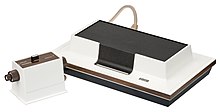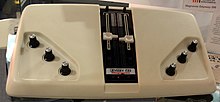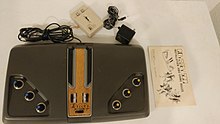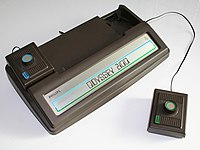
The Magnavox Odyssey 2, also known as Philips Odyssey 2, is a second generation home video game console that was released in 1978. It was sold in Europe as the Philips Videopac G7000, in Brazil and Peru as the Philips Odyssey and in Japan as Odyssey2. The Odyssey 2 was one of the five major home consoles prior to the 1983 video game market crash, along with Atari 2600, Atari 5200, Intellivision and ColecoVision.

Pong is a table tennis–themed twitch arcade sports video game, featuring simple two-dimensional graphics, manufactured by Atari and originally released on 29 November 1972. It was one of the earliest arcade video games; it was created by Allan Alcorn as a training exercise assigned to him by Atari co-founder Nolan Bushnell, but Bushnell and Atari co-founder Ted Dabney were surprised by the quality of Alcorn's work and decided to manufacture the game. Bushnell based the game's concept on an electronic ping-pong game included in the Magnavox Odyssey, the first home video game console. In response, Magnavox later sued Atari for patent infringement.

The Magnavox Odyssey is the first commercial home video game console. The hardware was designed by a small team led by Ralph H. Baer at Sanders Associates, while Magnavox completed development and released it in the United States in September 1972 and overseas the following year. The Odyssey consists of a white, black, and brown box that connects to a television set, and two rectangular controllers attached by wires. It is capable of displaying three square dots and one line of varying height on the screen in monochrome black and white, with differing behavior for the dots depending on the game played. Players place plastic overlays on the screen to display additional visual elements for each game, and one or two players for each game control their dots with the knobs and buttons on the controller by the rules given for the game. The console cannot generate audio or track scores. The Odyssey console came packaged with dice, paper money, and other board game paraphernalia to accompany the games, while a peripheral controller—the first video game light gun—was sold separately.
1972 marked an important landmark in the history of the video game industry with the releases of Pong and the Odyssey home console. The profile of electronic games rose substantially and companies began exploring the distribution of video games on a larger scale. Important mainframe computer games were created in this period which became the basis for early microcomputer games.
1975 had new titles such as Western Gun, Dungeon and dnd. The year's best-selling arcade game was Taito's Speed Race, released as Wheels and Wheels II in North America.

The Color TV-Game is the first video game system ever made by Nintendo. The system was released as a series of five dedicated home video game consoles between 1977 and 1983 in Japan only. Nintendo sold three million units of the first four models: one million units of each of the first two models, Color TV-Game 6 and 15; and half a million units of each of the next two models, Block Breaker and Racing 112. The Color TV-Game series has the highest sales figures of all the first generation of video game consoles.

The APF TV Fun brand is a series of dedicated home video game consoles manufactured by APF Electronics Inc. and built in Japan starting in 1976. The systems were among the first built on the General Instrument "Pong-on-a-chip", the AY-3-8500, that allowed many manufacturers to compete against the Atari Home Pong. The APF TV Fun consoles were one of the earliest Pong clone consoles.

In the history of video games, the first generation era refers to the video games, video game consoles, and handheld video game consoles available from 1972 to 1983. Notable consoles of the first generation include the Odyssey series, the Atari Home Pong, the Coleco Telstar series and the Color TV-Game series. The generation ended with the Computer TV-Game in 1980 and its following discontinuation in 1983, but many manufacturers had left the market prior due to the market decline in the year of 1978 and the start of the second generation of video game consoles.
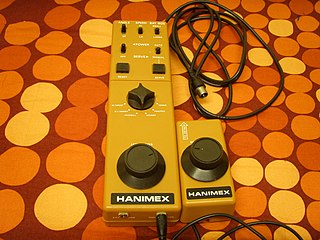
The TV Scoreboard is a Pong-like dedicated home video game console manufactured in Hong Kong from 1976 through the early '80s and made by Tandy. Distribution was handled exclusively by RadioShack.

The AY-3-8500 "Ball & Paddle" integrated circuit was the first in a series of ICs from General Instrument designed for the consumer video game market. These chips were designed to output video to an RF modulator, which would then display the game on a domestic television set. The AY-3-8500 contained six selectable games — tennis, hockey, squash, practice, and two shooting games. The AY-3-8500 was the 625-line PAL version and the AY-3-8500-1 was the 525-line NTSC version. It was introduced in 1976, Coleco becoming the first customer having been introduced to the IC development by Ralph H. Baer. A minimum number of external components were needed to build a complete system.
Unisonic Products Corporation was an American manufacturer and distributor of consumer electronics from the 1970s to the 1990s. Although headquartered in New York City, Unisonic outsourced its manufacturing operations to various facilities in East Asia. Unisonic developed a variety of electronics, including calculators, CRT television sets, video game consoles, digital watches, telephones, answering machines, and digital alarm clocks.

The 1970s was the first decade in the history of the video game industry. The 1970s saw the development of some of the earliest video games, chiefly in the arcade game industry, but also several for the earliest video game consoles and personal computers.

The Ping-O-Tronic is a dedicated first-generation home video game console produced by Zanussi, an Italian home appliance company, and released under their Sèleco brand in late-1974 only in Italy. It was the first Italian video game console, excluding Magnavox Odyssey imports and clones.
The Philips Tele-Game series was a series of six dedicated first-generation home video game consoles manufactured, released and marketed between 1975 and 1978 by Dutch company Philips.

The Turnir is a dedicated first-generation home video game console that was manufactured by the Ministry of the Electronics Industry and released in 1978 only in the Soviet Union. It was manufactured between 1978 and 1982 and is the only known Soviet video game console that uses the AY-3-8500 chipset from General Instrument. The price for the system varied from 150 Soviet rubles in 1978 to 96 rubles in the late 1980s. The console uses an integrated AC adapter with a voltage of 9 volt and has a mass of 2.5 kg.
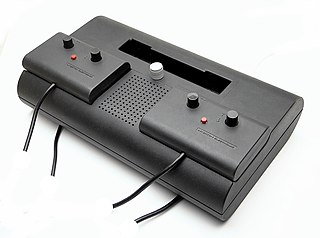
The Interton Video 2000 is a dedicated first-generation home video game console released in 1975 by Interton in Germany licensed by Philips (Magnavox), Germany. The console turns itself on automatically when a cartridge is inserted. This videoconsole uses cartridges to develop videogames.

The Interton Video 3000 is a dedicated first-generation home video game console that was released in Germany in 1976 by German manufacturer Interton and sold by Quelle. Due to the AY-3-8500 chipset from General Instrument, the console has six integrated games: Tennis, Football, Practice, Squash, Skeet and Moving target. It had a list price of 198 Deutsche Mark (DM).
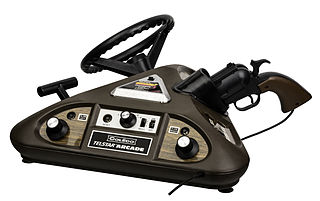
The Coleco Telstar Arcade, commonly abbreviated as Telstar Arcade, is a first-generation home video game console that was released in 1977 in Japan, North America and Europe by Coleco. It is the most advanced video game console in the Coleco Telstar series, based on the MOS Technology MPS-7600-00x chips series. Each chip is a microcontroller capable of storing 512 words of ROM.

The Interton Video 3001 is a dedicated first-generation home video game console that was released in 1978 by Interton. It is a Pong clone console and the successor to the Interton Video 3000 and the predecessor of the Interton Video Computer 4000. It could output games in color.

The Wonder Wizard is a dedicated first-generation home video game console which was manufactured by Magnavox and released by General Home Products in June 1976 only in the United States.
